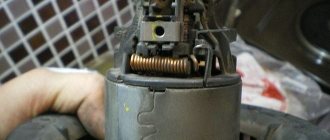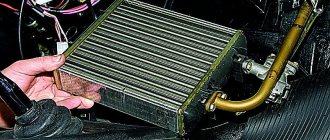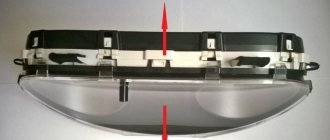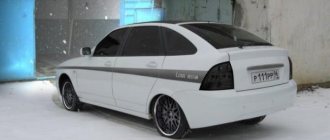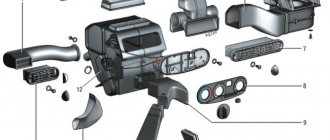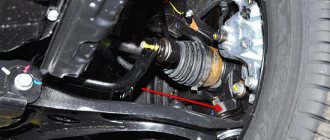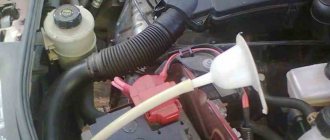With a broken stove, people in the car feel uncomfortable, both in winter and in summer. The stove is required to create a comfortable temperature; it is used to get rid of condensation on the glass; without it, the stability of the engine may be impaired. More often than not, the heater motor fails, and the popular Renault Logan car is no exception. You can solve the problem of replacing the motor yourself.
The heater motor for Renault Logan is supplied by two companies - Renault directly and a third-party manufacturer Valeo, both of them are considered original. Modifications are offered for cars with and without air conditioning. The first ones have a little more power, otherwise their design is identical, so repair and maintenance are no different.
How to replace the heater motor on a Renault Logan
Almost all Logan models are equipped with air conditioning. But in basic configurations the car is sold without this device. The owner of a Renault Logan needs to know what the difference is between the heater motors for models with and without air conditioning.
When selecting a new motor, you must remember that on models with air conditioning the motor power connector is very narrow, and on versions without air conditioning it is wide. Accordingly, if you bought the wrong motor for your Logan, then during installation you simply will not be able to connect the device.
If you need to get to the heater motor, you need to remove or bend the front panel trim in the cabin
Preparing tools
To quickly remove the old heater motor and install a new one, you will need:
- screwdriver with a thin flat blade;
- Phillips-blade screwdriver;
- plastic puller (can be replaced with a regular school ruler);
- Torex T20 key (included with the car).
To dismantle the heater motor you will need to install a T20 bit
After making sure that all the necessary tools are in working order, you can begin to remove the stove motor.
Model with air conditioning: operating procedure
Dismantling the electric heater motor on a Logan with air conditioning has its own nuances. The connected air conditioner makes the work somewhat more difficult, but you can still handle it yourself. You need to proceed according to the scheme below:
- Remove the seal from the door. It is most convenient to use a screwdriver with a straight and thin blade for this.
- Use a screwdriver to pry up the center console trim and remove it from the clips.
- After dismantling the console, the first screw will be visible; unscrew it with a Torex T20 key.
- Remove the plug in the lower right corner of the glove compartment.
- Unscrew the second screw with a Torex T20 key.
- The panel is completely disconnected from the body shell - you can’t pull it out, but you can look into the wide gap that has formed.
- Behind the panel is the heater motor housing. It has a round shape and is located next to the cabin filter.
- Remove the power connector from the motor, turn the housing clockwise and pull it out from behind the panel.
Photo gallery: replacement procedure
After this, you can insert the new motor into place - all installation steps are performed in reverse order.
Model without air conditioning: repair progress
Removing the heater motor from a Renault Logan without air conditioning will take less time, since you do not need to remove the seal from the door structure and work for a long time with the facing panel in the cabin. To work successfully you should:
- Remove the plug in the lower right corner of the glove compartment.
- Pry up the lining a little to gain access to the stove motor.
- Two screws will be visible behind the cladding; they need to be unscrewed with a Torex T20 wrench.
- After which the panel should be moved forward to get to the motor.
- Disconnect the connector from the motor housing and pull the device out from behind the panel.
- Install the new heater motor in place of the old one and then proceed in the reverse order.
Photo gallery: changing the heater motor on a Renault Logan without air conditioning
The driver can solve all problems that arise with the electric heater motors on Renault Logan independently. Regardless of the year of manufacture of the car and the configuration, you can replace the heater motor with a new one in just an hour and a half, if you follow the instructions strictly and use good tools.
Selecting an electric heater motor
Most Logans are equipped with air conditioning, but there are also cars without this device. It is important to know that the heater motors for versions with and without air conditioning differ in shape and power connector.
For versions with air conditioning, a heater with a wide connector is used
On the model with air conditioning, the connector is narrow, and on the model without it, it is wide. There is practically no difference in the procedure for replacing a part, as well as in its location. The Renault Logan heater electric motor is located under the front panel in the area of the center console. It can be reached through the front passenger footwell. There are quite a few manufacturers of this unit, but structurally their products, as a rule, do not differ from the original.
On versions not equipped with air conditioning, heaters with a narrow connector are installed
Removing and installing the heater of a Lada Largus car
Typically the heater is removed to replace the evaporator or to repair the heater.
Before completing the task, we discharge the air conditioning system, as described in the article - How to unload and load refrigerant from the Lada Largus air conditioning system
Draining the liquid from the engine cooling system (article - Replacing the Lada Largus engine coolant)
We remove the air intake with resonator assembly (article - How to replace the air filter of a K7M engine)
Removing the floor tunnel lining (article - How to remove the instrument panel of Lada Largus)
Removing the instrument panel
Inside the car, use a Torx T-20 wrench to unscrew the two screws securing the mounting block
Remove the fuse mounting block and leave it hanging on the wires
Using a 10mm socket, unscrew the two nuts.
Remove the terminals of the ground wires from the studs
Use side cutters to cut through the clamp securing the wiring harness to the cross beam
Using a screwdriver, remove the wiring harness holder from the steering column bracket.
We also remove five more wire harness holders from the cross beam
We remove the cross beam bracket (how to remove it is described in the article - Removing the heater elements of a Lada Largus car)
Remove the heated tailgate glass relay from the holder on the cross beam
Disconnect the wiring harness from the brake light switch
Using a 13mm socket, unscrew the four bolts securing the steering column
Lower the steering column to the floor
By pressing the latch of the wire block, disconnect the block of the heater fan wiring harness
Use a 10 mm socket to unscrew the nut.
Remove the ground wire tip from the stud
Using a Torx T-20 wrench, unscrew the screw securing the air duct
And remove the left air duct
We also remove the right air duct
Using a Torx T-20 wrench, unscrew the two screws securing the heater to the cross beam
Using a 13mm socket, unscrew the two bolts securing the transverse beam on the left side.
We also unscrew the two bolts securing the transverse beam on the right side
Removing the cross beam
We remove the upholstery from the front panel
In the engine compartment, use a 10 mm socket to unscrew the two bolts securing the air conditioning pipes to the gearbox
Disconnect the tubes from the gearbox
Squeeze the ends of the clamps with pliers and slide the clamps along the hoses
Disconnect the heater inlet and outlet hoses from the heater radiator tubes
Removing the heater from the car interior
Installation is carried out in the reverse order of removal, in this case:
— for vehicles equipped with an air conditioning system: remove the plugs from the pipelines and the evaporator unit, install new sealing rings on the pipelines.
Apply compressor oil to the sealing rings;
— perform evacuation of the air conditioning system and load the system with refrigerant, according to the operating instructions for the service equipment.
Check the operation of the heating, air conditioning and ventilation system.
Installing a new radiator
Replacing the heater radiator on a Renault Logan is required if coolant begins to leak through it. Replacing a radiator is the most complex and time-consuming process when repairing a car heater with your own hands.
Sequence of actions when replacing the radiator:
- Drain the antifreeze completely.
- Remove the instrument cluster and console trim.
- Remove the carpet fastening to the cross member bracket and bend the carpet back. First you need to remove the carpet
- Unscrew the bracket fastening (two bolts at the bottom and two nuts at the top). Unscrew the bracket fastening
- Release the bracket from the wires and remove it from the beam. The final stage is to remove the Renault Logan heater radiator mounts
- Replace the radiator and perform all the steps in reverse order, not forgetting to first put the rubber seals on the tips of the tubes.
Heating system design
It cannot be said that the Renault Logan ventilation and heating system is a weak point, but such a malfunction, especially in the cold season, promises unpleasant consequences. The operating principle of the interior heating system does not differ significantly from the device in other cars. But if the rear window heating does not work, then this can also spell trouble.
The heater radiator is connected directly to the cooling system, in which the coolant circulates (coolant, about replacing it here, about choosing a coolant here), which warms up within 95°C during engine operation. A special fan blows onto the hot radiator, which creates a strong air flow and directs it into the cabin through special air ducts. The quantity and speed of supply of heated air is regulated using a damper.
Signs of a malfunctioning stove
You should think about the upcoming repair and replacement of the stove motor if the following malfunctions are observed in its operation:
- An extraneous noise appeared when the stove was turned on.
- Warm air stopped flowing into the cabin.
- The speed of the incoming air flow has decreased.
- And of course, if the stove does not turn on at all. (However, in the event of such a malfunction, first of all analyze the condition of fuse F36, which is located inside the car. It is located in the green housing and is responsible for short-circuit protection of the heater system).
The fuse responsible for the operation of the stove is located on the right side of the block.
How to dismantle the fan?
The work involves performing actions on the right side of a Renault Logan car.
- We dismantle the rubber seal on the upper edge of the front door.
- Using the puller indicated earlier, we remove the decorative trim on the front (right) body pillar. The design of its fastening assumes the presence of latches. We recommend performing this action in warm weather conditions or in a heated box. This is required in order to avoid breakage of the plastic fasteners of the lining, which become more fragile in cold weather.
- Having dismantled the cover, we gain access to the first screw, which we “defeat” with a “star” wrench.
- The second mounting point for the panel is located below the glove compartment. It is hidden under a plug that should be removed immediately. Now unscrew the screw with a TORX wrench size “20”.
- Carefully place the right side of the front panel towards you. A gap opens, into which we penetrate with our hand and find the heater fan. The element is equipped with a round body. It is not possible to inspect it, so we carry out all actions by touch. Not entirely inconvenient, but possible.
- To remove the fan, rotate its housing in the direction of the clock hand. Disconnect the power supply connector. We remove this unit from under the dashboard and check it visually. Renault Logan has two types of fans, which differ slightly (wide or narrow connector).
Removing the heater system
Most Renault Logan owners are convinced that replacing the heater motor requires completely dismantling the front panel. The same position is described in the car repair and operation manual. Since such a process is quite expensive and inconvenient, many owners prefer to leave this problem unresolved. However, in reality, to dismantle the housing with the heater fan, it is enough to unscrew only a couple of screws. You can handle a similar task with your own hands.
But at the very beginning, make sure that the cabin filter is clean; sometimes, due to its contamination, air cannot get into the cabin. The filter is installed on the right side of the front panel.
If the filter is clean and its condition does not give you any doubt, you can begin dismantling the “stove”.
Tool for the job
To dismantle the heater we will need the following tools:
- Screwdriver with straight blade.
- Phillips screwdriver.
- Plastic puller (or a regular ruler).
- TORX T20 key.
What are the fan malfunctions and how to eliminate them?
The main cause of fan module failure is brush wear. Replacing the heater motor is not a difficult process. You should arm yourself with a Phillips-shaped screwdriver. Unscrew a couple of screws holding the case and remove it. We check the condition of the brush assembly and, if necessary, replace it with an analog part. Brushes with the following parameters are suitable for use: the cross-sectional profile is square with a side dimension of 4 mm, and the length of the product is 20 mm. If you purchased longer brushes, you will need to sharpen them to the required size.
As a mandatory step after assembly, lubricate the fan shaft. For this purpose, heat-resistant oil of the “ATF” class is suitable, used in automatic transmissions and power steering systems.
When the fan does not inspire hope for further “cooperation” with the heating system, we unconditionally replace it with a new one. When purchasing a product, we inspect the connector chip, remembering the duality of its design. A later modification of the fan is equipped with a narrow connector. To familiarize yourself in detail with the nuances of the procedure discussed here, we recommend watching a thematic video and replacing the heater motor will not seem difficult to you. When the owner is not confident in the success of this action, we recommend not to tempt fate with repair burdens, but to immediately trust in the skillful hands of selfless service workers, who will remove the stove motor in no time. The cost of this service ranges from 1500-1700 rubles. The choice is always up to the owner of Renault Logan!
Heater motor failure on Renault Sandero and Renault Logan: characteristic features
To say that the heater in Renault Logan and Sandero is a weak point would be wrong. But, nevertheless, some breakdowns sometimes occur. The stove motor is necessary to rotate the fan. This component is also subject to wear and tear during operation. The stove motor tends to fail not immediately, but gradually, trying to catch the driver by surprise.
Owners of Renault Logan and Renault Sandero, who have ever encountered a similar problem, note that at the first stage, problems with the engine make themselves felt by the fact that the heater begins to heat poorly. Then various extraneous sounds arise during its operation and, ultimately, the stove stops working. Most often, special brushes wear out, which many drivers try to replace with new ones. As practice has shown, this action is not as effective as replacing the motor itself with a new or relatively new one.
In any case, if the heater stops working, the first thing to do is make sure that it is not caused by a fuse problem or a dead battery. After which you can proceed to a more thorough inspection of the system, including inspection of the motor itself.
Causes of malfunction
Mechanisms tend to fail for one reason or another. A malfunction of the Renault Logan stove can be caused by wear of parts or mechanical failure. So, let's look at the main reasons for the failure of the Renault Logan stove and troubleshooting methods:
The most common cause may be a blown fuse. The fault can be fixed quite simply - replacing the fuse element with a new one. It is worth remembering that the markings on the old and new fuses must match.
Formation of an air lock in the system. This defect prevents hot fluid from circulating into the heater radiator. The treatment is quite simple - pumping the system and removing the resulting plug.
One of the most common malfunctions is the failure of the thermostat. Diagnostics and detection of malfunctions occurs during operation.
Another reason could be a clogged cabin filter. This malfunction is treated by replacing the element.
A more serious cause may be a fan failure or burnout of its winding. In this case, it simply does not turn when power is applied. Replacing the fan solves this problem.
The most catastrophic cause could be a clogged or broken stove radiator. Both faults can be treated by changing the unit. But many car enthusiasts try to blow out or solder the radiator. This certainly helps, but only for a while.
Let's make sure that the problem is in the motor.
Despite the low prices for spare parts for Logans, the heater motor is far from cheap. The cost of an original spare part can exceed 5 thousand rubles. Therefore, it makes sense to check whether the problem is really with the electric motor. A number of signs of a heater motor failure coincide with the symptoms of other malfunctions, the elimination of which will cost much less. Let's consider all the options.
Fuse
If the stove does not turn on, the first step is to find out whether fuse F36, which is responsible for protecting the heating system from short circuits, has blown. The fuse box on the Logan is located at the end of the instrument panel on the driver's side. If the fuse is blown, replace it. If the device is in order, or after replacing it the stove still does not work, you will have to continue troubleshooting.
The heating system fuse can be found on the right side of the block.
Wiring and connectors
Wiring problems can also cause the heater to malfunction. First of all, you should check the connections in the motor area. If you find that the plug is not inserted all the way, correct it. And also check the integrity of the wires. If everything is in order with the wiring and connections, and the heater still does not turn on, you should move on to checking the motor itself, as well as the heater mode switch, which is located on the center console.
Check whether the plug is firmly inserted into the power connector of the stove motor
Cabin filter
If the stove blows weakly, the problem is not necessarily the motor. It is possible that the cabin filter on your car is clogged. It is worth changing it every 15–20 thousand kilometers.
The filter is located in the lower part of the center console, in the footwell of the front passenger, but on some cars there is a plug on two screws in place of the slot. Filter elements were not installed on all Logans. If there is still a filter, remove it and check its condition. If it is clogged, be sure to replace it. To replace, use a new filter; a cleaned old one will only be clean in appearance.
You can get to the Renault Logan cabin filter from the front passenger side
This is interesting: Where is the Chevrolet Cruze engine number - photo
We change the electric motor of the stove with our own hands
You've checked the fuse, wiring, and cabin air filter to make sure everything is in order, but the problem still persists. It's probably the heater motor that's causing the problem. Dismantle it and check if it is in working condition. To work you will need the following tools:
- set of TORX heads;
- flat screwdriver.
Remove the heater motor following the instructions.
- Pry up the door seal on the front passenger side and remove it.
The seal cannot be removed completely, but only in the front and upper part of the opening - Remove the plastic trim of the front pillar.
The front pillar trim is held in place by metal clips - You will find a screw where the rack trim meets the front panel.
Unscrew it. You can unscrew the screw with a TORX t20 head - Remove the oblong plug to the right of the glove compartment using a screwdriver.
Open the cap carefully - Pull the front panel towards you to reveal a small opening. This should be done carefully, taking into account the fragility of the plastic.
- Looking under the pulled panel in the area of the center console, you will find the heater motor.
Disconnect the power cord from it, turn the housing clockwise and remove the assembly. The heater motor is located next to the cabin filter
After dismantling the heater electric motor, you should check its serviceability by connecting it to the battery through a wire. If it works, you should take a closer look at the stove mode switch block located on the center console. If the motor does not function, install a new one.
Replacing the stove fan yourself
The Logan heater fan is integrated into one unit with the motor, so it is dismantled along with it. Many Renault Logan car owners say that to dismantle it, you need to completely remove the central panel of the car, but there is a way to do this by simply unscrewing two mounting bolts.
To remove the stove fan, first remove the facing of the right pillar, you need to carefully pry it off with a screwdriver and pry off the two latches. It opens the top screw, which is unscrewed with a T20 screwdriver. At the bottom of the panel there is a plastic plug, under which there is another self-tapping screw with the same head.
After unscrewing the screws, the plug is closed and the door seal is completely removed so as not to damage them during operation. Afterwards you can remove the fan.
The panel is carefully removed from the guide elements. The Renault Logan heater fan is located under the glove compartment, installed in the air duct. You can see it even if you cannot bend the panel as far as possible; all manipulations are carried out by touch.
First, carefully disconnect the electrical connector, then remove the Renault Logan heater fan. To do this, press the latch and turn it clockwise until it clicks and pull it out of the mount. This pulls back quite a bit on the right side of the dashboard, so you have to be careful not to break the plastic.
The two types of fans differ in connectors and mounting to the case. Replacing the stove fan with a Logan is carried out after dismantling the entire assembly. You remove the cover and see the motor, if it works, just lubricate it with ATF from a syringe. If this does not help, you can ring it, check the brushes, but most likely the heater motor will need to be replaced. After inspection, maintenance or replacement of the unit, it is installed in place in the reverse order.
You can remove and change the heater motor on a Renault Logan yourself. This does not require any special tools or equipment. The only difficulty is that dismantling and reinstallation will need to be done by touch. But with some skill, this does not pose a problem. In order for the new part to guarantee reliability, it is better to buy a heater motor from the original manufacturers, which Renault recommends, there are only two of them. After installation, you need to check the reliability of the panel, the lining of the right pillar and the rubber seal. If this is not done, extraneous creaks and drafts will make the ride uncomfortable.
Video: Replacing the heater fan (stove) for Renault Logan, Sandero, Duster, Lada Largus
Renault Logan is one of the most commercially successful models of the French concern. It is produced in seven countries and sold almost all over the world. It’s not for nothing that the car has earned the love of car owners.
It is compact but roomy, handles well, is cheap to operate and surprisingly reliable. However, even the most reliable cars have breakdowns. In harsh Russian winters, a malfunctioning stove can become a serious problem.
If the heater motor fails, repairs at the service center can be expensive for the Logan owner. However, you can save a lot of money by replacing this unit yourself.
Blog Archive
I didn’t need to remove the instrument panel from the video, I just needed to remove it. Next, I will try to describe in detail the process of work performed. To begin with, I removed the seal of the front right door opening. The metallized U-shaped seal is simply put on the edge of the body pillar, we tighten it so that it does not interfere.
Next, the inner trim of the body pillar is removed, it is attached to metal latches inserted into the holes in the pillar. Having removed the cover, the top panel mounting bolt appears, unscrew it. At the bottom, under the plug, there is another bolt securing the panel; unscrew it in the same way.
There is a nuance here: unscrew the bottom bolt and snap the plug back, it is fragile and to avoid breaking it, it is better to snap it back. Next, we remove the central tunnel. I wrote about this in Installing a gearbox lock. 2 central lower bolts for fastening the instrument panel appear, unscrew them. Next, you need to remove the center console trim and the radio; these operations can be viewed in Installing a radio; under it we need to unscrew the central upper mounting bolt.
Either the Renault officials have gone completely crazy, or the euro exchange rate is making itself felt. Just for fun, I called an auto parts store, and they found a ruble motor. Of course, this is not the original, but it could be considered as an option. There is still a question about replacement.
Site navigation
But I still have hope that the motor is still alive, and I just need to clean it and lubricate it. I started looking for a video on replacing the heater motor and accidentally came across this video, which shows a replacement method without removing the entire panel: I decided to try this method to remove the heater motor and carry out preventive maintenance. In the video, I personally did not understand some of the nuances that were successfully resolved during the work, and which I tried to describe in my photo report on replacing the heater motor.
So, it happened in a city yard, there was not much time, and there were no suitable dirty clothes for repairs.
So to speak, the repair is “on the knee”.
In order to remove the motor, you need to reach deep under the panel with your hand, and to do this you need to either lie with your back on the floor of the front passenger with your legs thrown up on the passenger seat, or kneel next to the car in the area of the front passenger door, and then lie on your stomach .
I chose the second option. To avoid getting dirty, I pulled out the front passenger mat, turned it over and placed it on the ground near the car. The bottom side of the rug was clean enough to kneel on, but the dirty top side was lying in a puddle; it was raining: Then I threw an almost clean rag I found on the front passenger door sill.
The interior carpet was clean enough, and now I could kneel next to the car, lie on my stomach on the floor of the front passenger and find myself with my head under the instrument panel in the glove compartment area, you know in what position: Now, in the theory taken from the video, I should have reached the motor, but where he actually is is not immediately clear.
My hand first felt some kind of rectangular protrusion and for some time I could not find the motor cover, which felt round to the touch. Then I finally found it a little higher and deeper than this ledge. I had a camera at hand, and I decided to use it for probing: In addition, these photos helped to easily figure out how to properly disconnect the chip with the wires without breaking anything. Let's go on a virtual photo tour under Logan's dashboard: Here we are lying on the carpet of the front passenger's floor and looking at the "torpedo beard" area.
Some elements of the stove are visible there. By the way, this picture seems to show the place where Logan’s cabin filter is inserted.
Main malfunctions of stove motors
Most often, the cause of heater motor failure is natural wear and tear of its parts. During long-term operation, metal aging is an inevitable evil, since brushes, rings and bearings have a limited resource. Less often, the motor fails due to electrical problems - for example, broken wires or oxidized contacts. And also, motor malfunction can be caused by a very simple reason - the production of lubricant.
Typically, the driver of a Renault Logan car can independently diagnose problems with the motor. The occurrence of malfunctions is judged by the following signs:
- change in the sound of the stove;
- heat output has become uneven and weak;
- The stove is difficult to turn on.
If the operation of the stove does not correspond to the specified settings, this indicates a problem with the motor.
The stove began to whistle
Often the driver hears a loud whistle while the stove is operating. The sound comes from under the center console housing and indicates a breakdown of the motor bearing or the appearance of strong play on the device shaft. If the stove starts whistling during operation, it will soon stop functioning normally, so it is best to immediately replace the motor with a new one.
Lubricating the motor is recommended for preventive purposes, but as a repair step, the procedure will not eliminate the whistle of the stove for a long time
Why does the stove jam or not turn on?
Owners of old Logans are well aware of the situation when the stove does not turn on. Usually the malfunction is eliminated by hitting the center console on the right side. The stove then immediately starts working.
There may be several reasons for the mechanism to jam:
- the bearing has become loose;
- severe shaft wear;
- lack of lubrication;
- wear of motor brushes.
Hitting the dashboard cannot be considered an effective method for restoring the functionality of the stove
When the stove blows weakly
Usually the driver does not immediately notice problems with the stove. Most often, a weak flow of warm air with the curtains open to maximum causes bewilderment in winter: it is cold in the cabin, although the stove should produce a strong flow of heat. Sometimes drivers notice that in the fourth mode the device works even weaker than in the second.
The cause of the breakdown is a short circuit or failure of the motor. In rare cases, the cabin filter may simply be severely clogged. Accordingly, you will have to remove the heater motor and filter element and see what exactly is the cause of the malfunction.
If the stove blows very weakly at maximum, then you need to change the motor
Reduced air flow from the stove
This problem occurs when the curtains on the center panel are fully open. During the cold season, even with full power, the car still remains cold. The driver notices the problem only after a while; the windshield may not freeze at sub-zero temperatures, limiting visibility. Often in the fourth position the air flow is less intense than in the second.
The main reason for such a breakdown is a problem with the motor. Less commonly, the cabin filter is clogged. In this case, you need to disassemble the stove and inspect the engine and cabin filter. Only then will it be possible to identify and eliminate the cause of the malfunction.
What kind of heater motors are installed on Renault Logan cars?
Renault Logan is usually equipped with electric heater motors from two different manufacturers - Renault and Valeo. Both French companies produce motors for both models equipped with and without air conditioning.
The main difference between motors for cars with air conditioning systems is their slightly higher operating power. Otherwise, there is no significant difference between the modifications of the motors.
The original motor costs more, but it makes sense to buy a higher quality product, since it will last much longer than cheap analogues
Valeo electric heater motors are ideal for both Logans with and without air conditioning
Electric heater motors from the domestic Luzar plant are intended exclusively for Renault Logan cars and a number of other brands that are not equipped with air conditioning.
Luzar is a Russian plant for the production of auto components; the manufacturer's heater motors are installed on Logans without air conditioning.
Self-replacement
Work to replace the heater motor must be carried out in the following sequence:
- the entire panel is removed;
- the air supply knob switches to the “air blowing to the upper part of the cabin” position;
- The power connector on the motor is disconnected;
- the fan rotates clockwise a quarter turn after pressing the latch, which helps to remove it from the case.
The listed steps are basic, so inexperienced drivers are advised to read the full instructions in the video presented.
On a Largus model car, replacing the stove will take a minimum of time if all actions are carried out carefully in the specified sequence.
It is important not to damage fragile components to avoid the need to replace them
Signs of a faulty Renault Logan heater motor
More often, the cause of a stove motor breakdown is wear and tear of parts over time, since rings, brushes and other moving parts will sooner or later fail. Less common are problems of an eclectic nature - oxidation of contacts or broken wires. Often the lubricant on the moving parts of the motor and fan simply runs out.
Signs that the Renault Logan heater fan is working in abnormal mode and the unit will soon fail can be determined by certain signs:
- the stove changes the sound during operation, the noise increases;
- the heat flow becomes uneven and weakens;
- The stove does not turn on the first time or takes a long time to gain momentum.
The stove is jamming
You can often hear stories from owners of Renault Logan cars that the heater does not turn on until you hit the center console on the passenger side. The causes of jamming are most often the same, that is, problems with the bearing, shaft or lubrication. In addition, the stove may jam due to wear on the motor brushes.
They can be replaced separately, but finding suitable ones can be quite difficult. In addition, replacing brushes does not guarantee proper operation of the unit.
Wear of the motor brushes leads to jamming and failure of the stove
Wear of the motor brushes leads to jamming and failure of the stove. Car owners do not immediately notice this malfunction. Usually it comes to the point that in the fourth mode the stove works weaker than in the second before it breaks down. Low air supply intensity can mean either a breakdown of the electric motor or a clogged cabin filter.
Find out more about the new Logan
- Renault Logan Location of fuses, fuses and relays and their replacement
- Fuse and relay block Renault Logan 2, their description
- Relays and fuses Renault Logan 2: block diagrams - New Logan
- Renault Logan 1.4 and 1.6 speed sensor: how to remove, article number
- Removing the air conditioning compressor | Renault | Renault Guide - New Logan
- Renault Logan power steering repair, oil (fluid) change in the power steering - New Logan
- Renault Logan remove replacement repair Removing the shock absorber strut and disassembling it Renault Logan - New Logan
- How to remove Renault Logan windshield wipers - Auto Magazine
How the device works
The above-mentioned unit is designed specifically for this type of vehicle. It allows you to regulate the direction of movement of warm air in relation to the people sitting there. Thus, a concentrated hot stream is mixed with salon coolness and delivered “at the place of demand.”
The essence of the stove's operation is based on the reflection of the air flow from the plane. The laws of physics work perfectly with it - it spreads, creating rarefaction and draft. It is worth noting that the effectiveness of this device increases significantly if it is located successfully. The overall increase in thrust leads to a significant increase in efficiency, raising its level by 20%.
As practice shows, the stove can be made not only of plastic, but also of metal. Of course, the second option will cost less than the first, but it still loses in design. However, plastic is not as durable as metal, so it is preferable for domestically produced vehicles.
Troubleshooting the heating system
The functionality of the entire system immediately comes into question if the stove on Largus is not cleaned before use after a long break. This can also be affected by turning on its engine while the engine is not running: the coolant does not circulate and the interior stops heating. To somehow correct this situation, you can use one of two methods:
- synchronize the operating mode of the stove with the ignition turned on, that is, reinstall the wires of the control relay;
- Connect the thin conductor of the heater motor to partially protected wires located nearby.
Changing the fan
If after the above manipulations the stove still does not heat, the reason may be that the Renault Sandero fan or fuse F36 is broken. A common problem with its breakdown is wear of the brushes. Replacing them is quite simple, just have a Phillips screwdriver, then:
- Unscrew the screws from the housing cover that closes it.
- We check the condition of the brushes and, if necessary, replace them (the cross-section should be 4×4 millimeters and the length 2 centimeters)
- Putting everything back together in reverse order
During repair work, you need to lubricate the motor axis, after which the operation of the stove may improve. You can use ATF lubricating oil or its equivalent. Very rarely, the cause of a breakdown may be a blown fuse.
Repair
As a rule, the Renault Logan heater fan fails due to the fact that its brushes wear out. To replace them, you need to press out several latches and unscrew two bolts with a Phillips screwdriver. When access to the brushes is obtained, we look at what condition they are in and, if necessary, replace them.
New brushes should have the following overall dimensions: length no more than two centimeters, and width four by four millimeters. Before installation, all elements that rub must be lubricated with high-temperature oil.
If there are problems with the body or some parts have burned out, then in this case the entire part needs to be replaced.
Installation is carried out in the reverse order, this is done in such a way that the part being replaced sits exactly in its place. If all actions are done correctly, the lid should snap easily, and the motor itself should be motionless. We check the operation, if everything is fine, then the part should not jam and rotation should occur without any problems at any speed.
As you can see, all the work can be done independently without the help of specialists, and replacing the Renault Logan heater motor will take you no more than one hour, but in any case, you need to study the instructions in detail before work.
Let's make sure that the problem is in the motor.
Despite the low prices for spare parts for Logans, the heater motor is far from cheap. The cost of an original spare part can exceed 5 thousand rubles.
Therefore, it makes sense to check whether the problem is really with the electric motor. A number of signs of a heater motor failure coincide with the symptoms of other malfunctions, the elimination of which will cost much less. Let's consider all the options.
If the stove does not turn on, the first step is to find out whether fuse F36, which is responsible for protecting the heating system from short circuits, has blown. The fuse box on the Logan is located at the end of the instrument panel on the driver's side. If the fuse is blown, replace it. If the device is in order, or after replacing it the stove still does not work, you will have to continue troubleshooting.
You will find the heating system fuse on the right side of the block.
Installation of a new electric motor
Mostly, the failure of the electric motor is associated with problems in the fan, which most often stops working due to serious wear of the brushes. Therefore, it is advisable to inspect this unit. If the brushes are defective, they need to be replaced. To do this, depending on the modification, press out 3 latches or unscrew 2 bolts.
Installation of a new unit is carried out in the reverse order of dismantling. Some tips:
- When installing the electric motor, it is important to accurately install it in its normal place. You can feel its edges with your fingers and carefully insert the motor. And, if everything is done correctly, a click will be heard - this is the lid slamming shut. The electric motor is fixed motionless.
- The plastic cover may resist during installation; you can knock on it with your fist: first from below, then on the central part, then at the top. When it clicks into place, you will hear a click.
- There are usually no difficulties with the seal.


